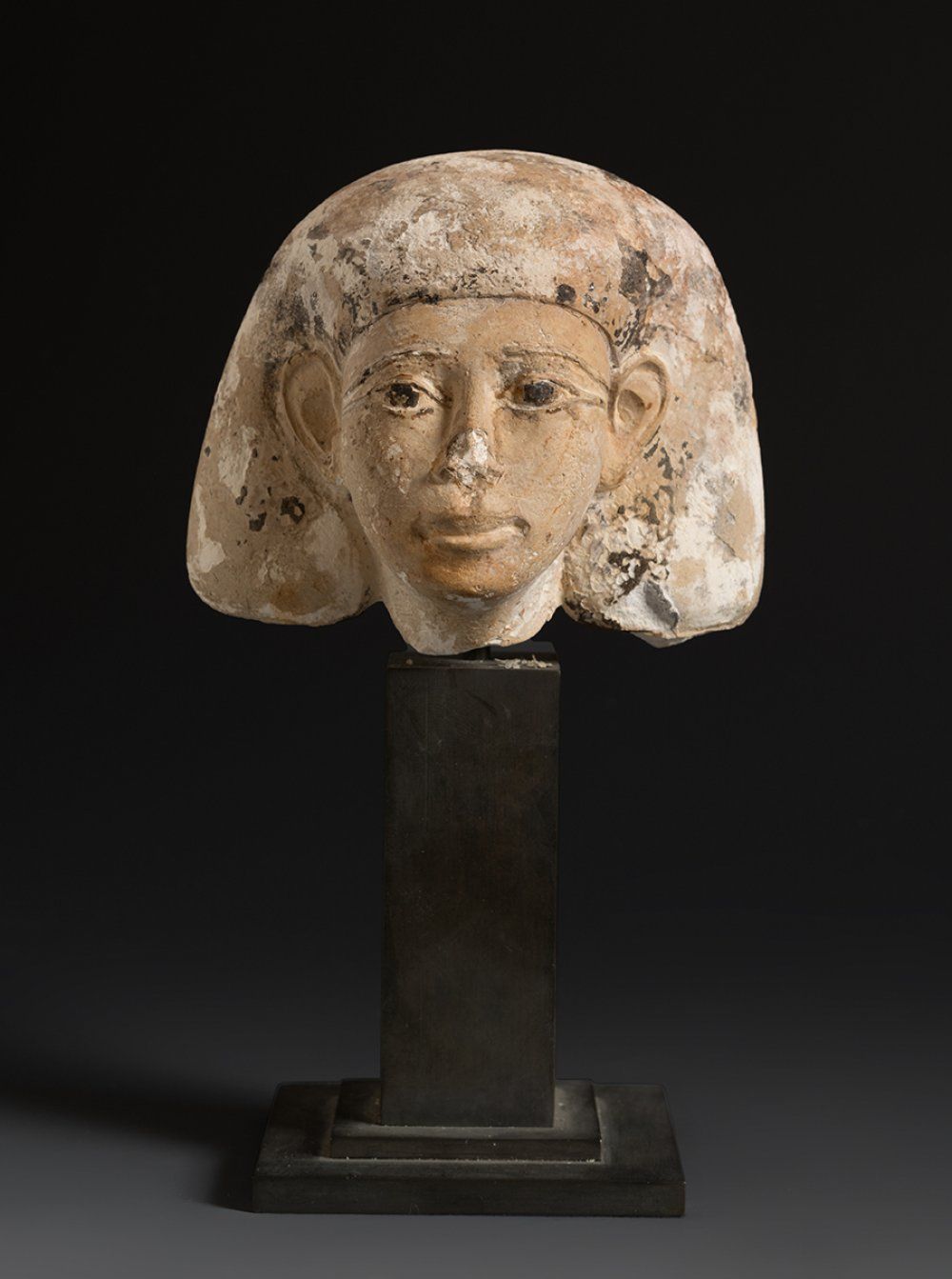Description
Upper part of a sculpture of a nobleman. Ancient Egypt. 26th Dynasty, 664-525 BC. Limestone and pigments. Provenance: private collection of Dr. E.R.M. Defecer, Gistel, Belgium. Acquired from Jacques Billen on 17 February 1996. Good state of preservation. Presents original polychromy. Attached Certificate of authenticity issued by Jacques Billen on 17 February 1996. Measurements: 6.5 cm high and 8 cm long; 14.2 cm high with base. Head of a nobleman, belonging to a full-length sculpture. The softening of the features with respect to the Haute Epoque can be seen. The symmetry provided by the headdress and the slanted eyes, framed by fine eyebrows, remains, but the hieratic rigidity diminishes during the Low Period. He wears a wig and has a peaceful expression, which gives the object a special mysticism and timelessness. These details make it clear that this is a representation of an important figure in Egyptian society. This sculpture belongs to the New or Late Empire, a period in which different artistic styles coexisted, which is why it is often referred to as eclecticism. After a period of Aegean and Asian influences that led to a softening of forms, Egyptian art moved towards a more realistic approach in the period of Amenophis III, as seen in the "Portrait of the Pharaoh and Queen Tiyi", which culminated in the reign of Amenophis IV. In the royal workshops the works are given a final treatment that accentuates the sensuality of the forms, as a result of the search for a new definition of the human body. Composite statues that swell the numerous busts of princesses. At the time of Ramses IV, the classical balance was restored, as can be seen in the group of the pharaoh seated between Isis, Osiris and Horus. In the sculptures of notable personages, the New Empire did not bring any variations, although a certain preference for offering figures can be discerned, "Ramsesnajt kneeling". In the lower period, the portraits of age, "green head" from Alexandria, persisted. In the New Empire the pharaoh is not so much the incarnation of divinity as the head of the nation, hence his deeds must be commemorated in visible places: Thutmes III subdues a group of Asians with his arm on the seventh pylon of Karnak, just as Amenophis II stands on his chariot on the third pylon of the temple of Amun-Ra. With Amenophis IV the king became Akhnaton and the solar god was represented on the reliefs of Tell-al-Amarna. It was from the 18th Dynasty onwards that the pylons of the temples featured large bas-relief decorations.
84
Upper part of a sculpture of a nobleman. Ancient Egypt. 26th Dynasty, 664-525 BC. Limestone and pigments. Provenance: private collection of Dr. E.R.M. Defecer, Gistel, Belgium. Acquired from Jacques Billen on 17 February 1996. Good state of preservation. Presents original polychromy. Attached Certificate of authenticity issued by Jacques Billen on 17 February 1996. Measurements: 6.5 cm high and 8 cm long; 14.2 cm high with base. Head of a nobleman, belonging to a full-length sculpture. The softening of the features with respect to the Haute Epoque can be seen. The symmetry provided by the headdress and the slanted eyes, framed by fine eyebrows, remains, but the hieratic rigidity diminishes during the Low Period. He wears a wig and has a peaceful expression, which gives the object a special mysticism and timelessness. These details make it clear that this is a representation of an important figure in Egyptian society. This sculpture belongs to the New or Late Empire, a period in which different artistic styles coexisted, which is why it is often referred to as eclecticism. After a period of Aegean and Asian influences that led to a softening of forms, Egyptian art moved towards a more realistic approach in the period of Amenophis III, as seen in the "Portrait of the Pharaoh and Queen Tiyi", which culminated in the reign of Amenophis IV. In the royal workshops the works are given a final treatment that accentuates the sensuality of the forms, as a result of the search for a new definition of the human body. Composite statues that swell the numerous busts of princesses. At the time of Ramses IV, the classical balance was restored, as can be seen in the group of the pharaoh seated between Isis, Osiris and Horus. In the sculptures of notable personages, the New Empire did not bring any variations, although a certain preference for offering figures can be discerned, "Ramsesnajt kneeling". In the lower period, the portraits of age, "green head" from Alexandria, persisted. In the New Empire the pharaoh is not so much the incarnation of divinity as the head of the nation, hence his deeds must be commemorated in visible places: Thutmes III subdues a group of Asians with his arm on the seventh pylon of Karnak, just as Amenophis II stands on his chariot on the third pylon of the temple of Amun-Ra. With Amenophis IV the king became Akhnaton and the solar god was represented on the reliefs of Tell-al-Amarna. It was from the 18th Dynasty onwards that the pylons of the temples featured large bas-relief decorations.
